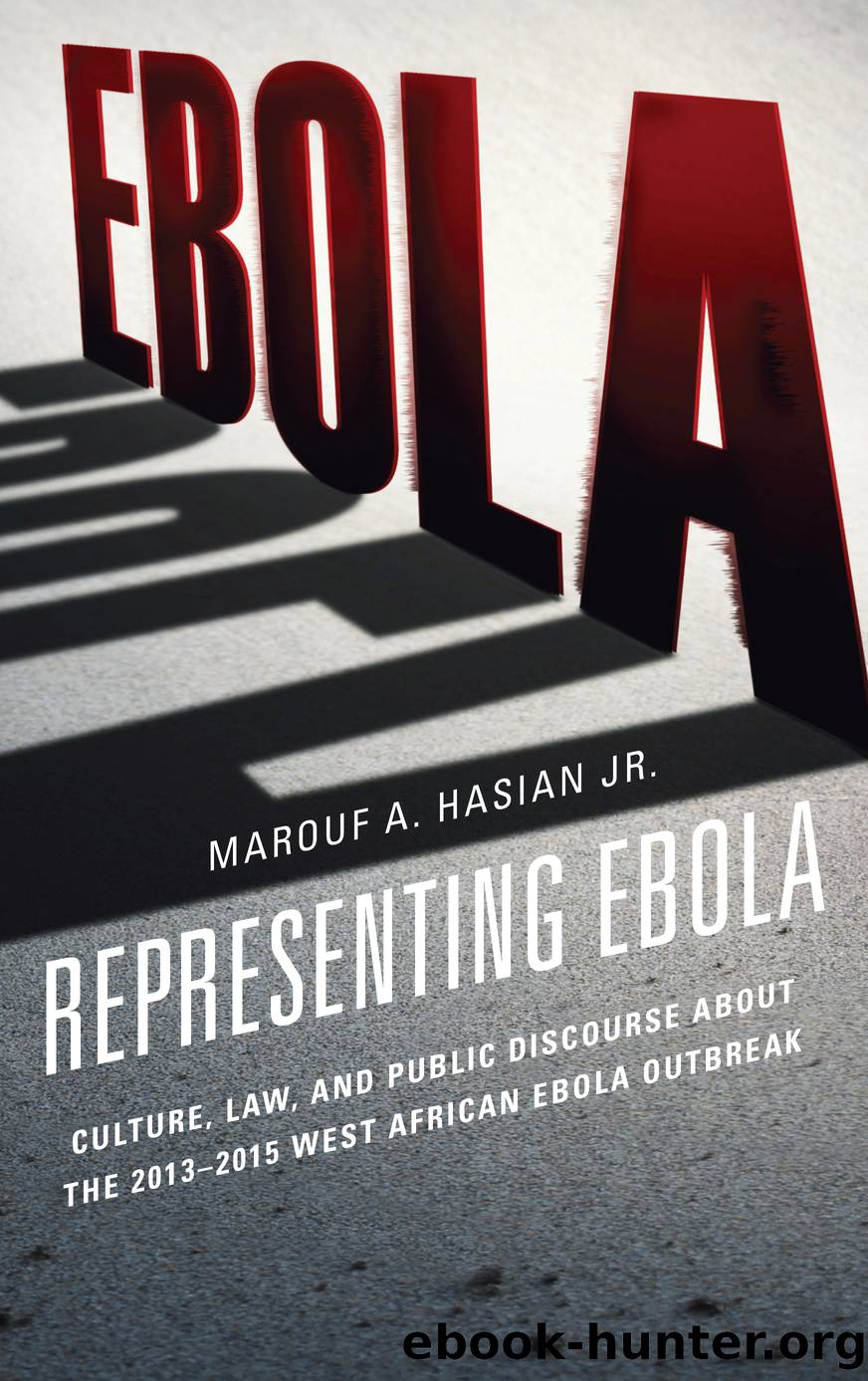Representing Ebola by Hasian Marouf A. Jr.;

Author:Hasian, Marouf A., Jr.; [Hasian, Marouf A. Jr.]
Language: eng
Format: epub
Publisher: Fairleigh Dickinson University Press
Published: 2016-08-15T00:00:00+00:00
6
Anticipating the Ebola Apocalypse and American Mediascapes
Government authorities, public health officials, and journalists who talk and write about the spread of infectious diseases have a difficult time drawing that mythic line that is supposed to exist between providing citizens with adequate warnings and creating moral panic.1 As Laurie Garrett would write in February of 2015, it seems as though âhumans always overreactâ during disease outbreaks because they each have âsocial and political ramifications that go far beyond anything that sound reasonableâ as we try to handle âthe interaction of our species with a particular set of microbes.â2 The stories that are still told about the U.S. governmental response to the outbreak of âSpanish fluâ in 1918, for example, remind us that responsible social agents sometimes made the mistake of not sounding needed alarms. Critics of American policies during that period later complained that the public had not been adequately warned before bodies started piling up during a global pandemic that killed millions.3
At other times governmental officials, and members of the media, donât err on the side of caution, and instead of allaying fears they anger communities when they are accused of hyping threats, such as the infamous 1976 swine flu âdebacle.â4 All of this becomes incredibly complicated in public health contexts when so many stakeholdersâpharmaceutical companies, government officials, public health employees, doctors, nurses, and othersâbecome participants in cultural and legal debates about what to do in âemergingâ infectious disease contexts.
This particular chapter draws from the work of Arjun Appadurai and his discussion of âglobal culturalâ flows like âmediascapesâ and âideoscapesâ so that I can put on display the ways that films, popular books, and media displays circulate Ebola dispositifs that reflected and refracted what American audiences wanted to see and wanted to hear about disease prevention and containment.5 While many mass media scholars are surely right to point out that the media uses particular epistemic or axiological âframesâ to help set the agenda during salient controversies, they often do so in ways that are circumscribed and informed by audience expectations.
Journalists and other social agents involved in the production of mediascapes co-produce these Ebola rhetorics, and they do so in dynamic and recursive ways. For example, both media outlets and public audiences are involved in the decisions that are made to grant, or to withhold, scientific legitimacy in public health contexts. They get to decide who are the contending, and the pretending, âEbola experts.â These decisions, in turn, impact the ways that communities view clarion calls that a particular event constitutes a âcrisis,â as well as the ways that populations evaluate potential solutions to perceived crises. Stephen Collier and Andrew Lakoff recently commented on how both the manufacturing of crisis, as well the production of solutions, were all parts of what they called a âvital systems securityâ diagram âof power.â6
The heuristic value of applying some of Appaduraiâs conceptual apparatus in studies of global exchange of information, epistemes, and other figurations for critical cultural scholars comes from the ways that
Download
This site does not store any files on its server. We only index and link to content provided by other sites. Please contact the content providers to delete copyright contents if any and email us, we'll remove relevant links or contents immediately.
Human Diseases (MindTap Course List) (by Team-IRA) by Marianne Neighbors Ruth Tannehill-Jones(846)
The Neglected Dimension of Global Security: A Framework to Counter Infectious Disease Crises by National Academy of Medicine Secretariat(422)
Statistical Methods in Health Disparity Research by J. Sunil Rao(399)
Imaging in Urology by Mitchell Tublin MD Joel B Nelson MD(395)
Short Course in Medical Terminology by Nath Judi L.;(331)
Cancer Cell Culture by Unknown(328)
Wilkins' Clinical Practice of the Dental Hygienist by Boyd Linda D.;Mallonee Lisa F.; & Lisa F. Mallonee(301)
Clinical Research in Occupational Therapy, Sixth Edition by Martin Rice;(300)
Murray's Basic Medical Microbiology E-Book by Murray Patrick R.;(282)
Anatomical Kinesiology by Gross Michael;(281)
Psychedelics As Psychiatric Medications by Nutt David;Castle David;(272)
Health Behavior: Theory, Research, and Practice by Karen Glanz & Barbara K. Rimer & K. Viswanath(272)
Neuroscience Fundamentals for Rehabilitation by Lundy-Ekman Laurie(271)
Achieving Procreation : Childlessness and IVF in Turkey by Merve Demircioğlu Göknar(252)
Rang & Dale's Pharmacology 9th Edition plus Flashcards 2nd Edition by Unknown(250)
Public Health and Society: Current Issues by Burke Lillian D.;Weill Barbara;(246)
The Handbook of Medicinal Chemistry by Simon E Ward;Andrew Davis;(245)
Primary Care Occupational Therapy by Unknown(239)
From Good Schools to Great Schools by Susan P. Gray & William A. Streshly(232)
